#composite pattern real world example
Explore tagged Tumblr posts
Text
Composite Pattern Tutorial Explained with Java Example | Composite Pattern Vs Inheritance
Full Video link https://youtu.be/Dzg9ZMuQFHc Hello friends, #Compositepattern video in #Java #Design #Pattern is published on #codeonedigest #youtube channel. This video covers topics 1. What is #Compositedesignpattern? 2. What is the use of Composite
Composite design pattern allows different objects in a similar fashion. Using composite design pattern, we can treat single object or composition of objects uniformly Composite pattern is a type of structure design pattern which describe how classes and objects are related. This is a best tutorial of Composite design pattern with the Java example. ** Topics Covered ** 1. Recap of Bridge Design…

View On WordPress
#Composite design pattern#composite design pattern java#composite design pattern java example#composite design pattern real world example#composite design pattern uml#Composite Pattern#composite pattern explained#Composite pattern in design pattern#Composite pattern java#composite pattern java example#composite pattern javascript#composite pattern real world example#composite pattern vs chain of responsibility#pattern
0 notes
Text
A friendly wizard and style reference.
Midjourney has just released both the version 6 of its niji anime engine and the first version of its "style reference" tool.
Functionally this is a variation of the image prompting system (explained here), in which breaks a submitted image down into the 'token language' the AI uses internally and uses that as a supplement to a text prompt. "Style Reference" (or 'sref') lets you do this with up to three images, only with only the tokens associated with 'style' being drawn upon.
This is not to be confused with style transfer, a much older and very different AI art process.
But what is a style in this context? And how does it affect generation?
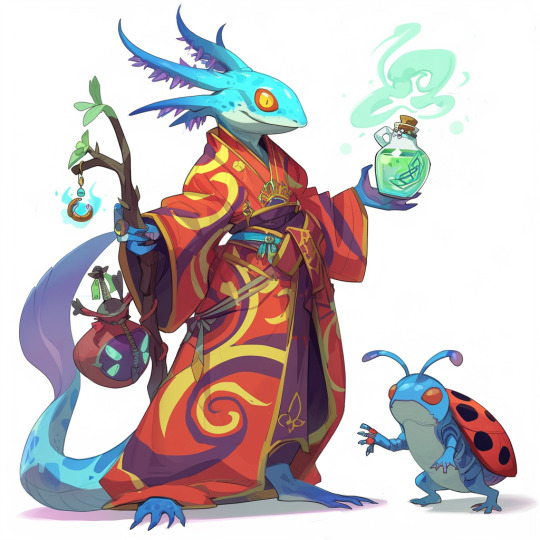
Prompt: a blue axolotl-anthro wizard in a red-and-yellow swirl-pattern robe, holding a sheleighleigh made of purple wood and a potion full of glowing green energy drink. A blue-and-green ladybug familiar stands near his feet, white background, fullbody image
Settings: --niji 6, --style raw --s 50 --seed 1762468963
Here, I've tested the same seed and prompt with a number of reference images.
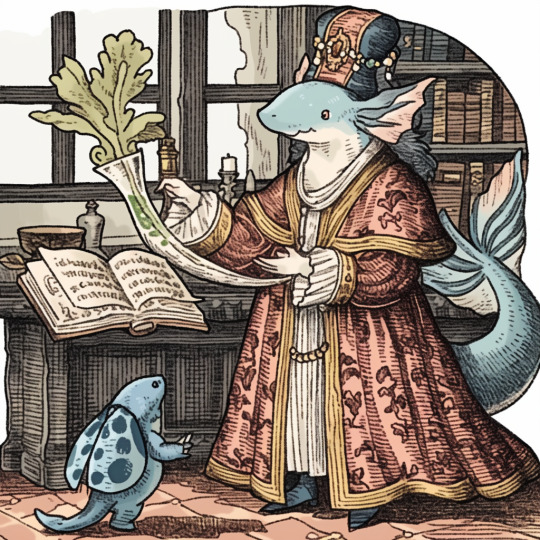


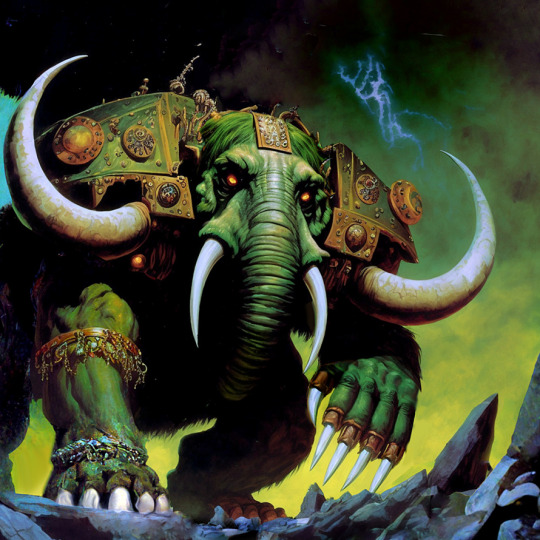






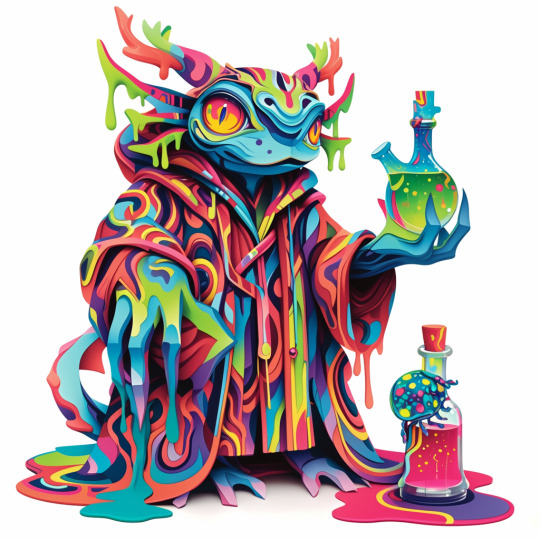




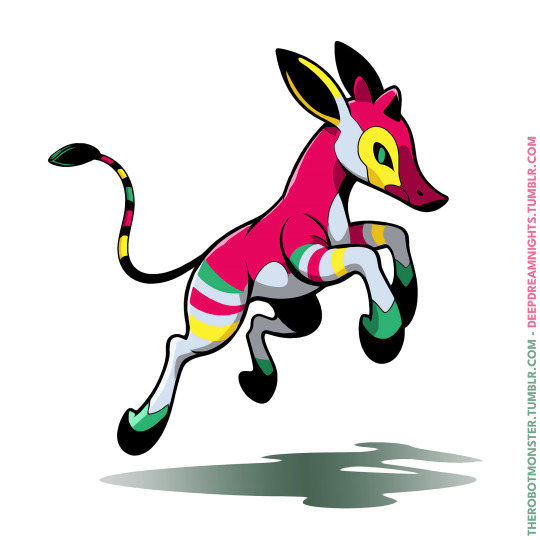


My semiorganized ramblings under the fold
The first thing I note is that style reference affects the gen so much that same-seed/different style ref comparisons are kind of pointless. Way too much of pose, composition and content changes for it to matter, so for future style ref tests, I'm probably going to drop the seeds.
The second thing I note is that there are certain limitations. You need to change up your prompt for things like photography, and the system interprets styles using its own criteria, not ours. If image prompting misinterprets something, so will style ref, but perhaps not in the same way.
This is notable for the one prompted with a scan from the Nuremberg Chronicle (first row). It recognizes that its a woodcut and emulates that general vibe nicely, but MJ is highly tuned for aesthetics, and emulating real world jank and clumsiness is a weak area. This is literally the first printed (european at least) book with illustrations. Every example thereafter is building on that skillset, so the dataset for woodcuts is going to be largely of a higher apparent quality.
In short, with Midjourney, additional prompt work is needed to replicate the look of early jank or intentionally 'ugly' art styles, and even as recent as v6 I've had no luck with things like midcentury Hanna-Barbereesque cheap TV animation styles or shitty 1990s CGI.
Style reference can help, I've gotten some pretty good cheap 80s-90s TV animation looking stuff from v6 niji and style ref in my early tests:



Color observations: Absent specific requests in the prompt, SREF will stick pretty close to the palette and lighting conditions of the referenced image. With such instructions, you get blending, so the one referencing the okapi fakemon (second row from bottom), for instance, has a lot of colors the reference image doesn't have, but they're in similar in vibrancy and saturation.
One limitation, however, is it doesn't apply to the aspects of the gen that come from any image prompts, so it will always blend the style of the style reference with the style aspects inherited from the image prompt, and that is very strong compared to the style ref.



Using the dog as the image prompt, and the TFTM reformatting as the style prompt, and the text prompt: "a cute older yorkie dog sitting on a bedspread", we get the image on the left. Dropping the image prompt weight to .25 gets us the center option, and removing the image prompt entirely produces the one on the right.
I expect this will be patched eventually, or general image prompting may fall out of favor compared to a combination of style ref and the upcoming character reference option, which will be the same thing, but will only reference the tokens associated with the character in the reference image. Depending on how that works that will have a lot of uses.
Stay tuned for more experiments. There's some good potential for freaky, unexplored aesthetics with combinations of multiple style refs and text prompts.
#ai artwork#style reference#midjourney v6#nijijourney v6#generative art#axolotol#wizard#prompt testing#ai experiments
55 notes
·
View notes
Text
Domesticated pigs
Domesticated pigs are famous for being messy, disgusting, and dirty, but they are actually quite clean and intelligent little guys. They communicate in a variety of ways, and grow to “market weight” in 5-7 months. This is quite a transformation. they are also able to root out many different foods from the ground, most commonly known for their truffle harvesting.
Behaviors
Pigs, once mutated have developed an even more sensitive nose, they frequently scavenge for food, they have developed even better burrowing skills, and carve out small chambers in the side of hills. but are quite docile under the Texas heat. So for days in which the temperature is over 60 degrees, they prefer to stay in their dens, and instead scavenge during the night. This makes them more crepuscular in the spring and summer, and more diurnal in the winter and fall.
They are very social creatures and often make dens composed of multiple connected chambers with a complete social hierarchy, with the dominant one having the deepest and most insulated chamber. Pigs will also frequently use pieces of the brush to camouflage the entrance of their dens and keep the heat out. When encountering other droves of pigs they are frequently curious and social with each other. And are very passive unless cornered, in that case they’d be mostly defensive.
Diet
As stated before they mostly scavenge for roots and other such things, however they’ll also eat carrion, bone, fresh carcasses, fruits and vegetables, and of course grains. Similar to real world pigs, the diet each has will change how much their excrement smells. The mutated pigs are different in this way as it’s not only the smell that changes but also the composition of the gasses. When eating more poor quality foods the gas they produce has a noxious effect to the health of those exposed to it for long periods of time or in high concentrations. This effect can range from simply being unbreathable (can’t get oxygen from it) or creating mild hallucinations and shortness of breath, to slight chemical burns, weakness, and nausea.
Rage
Pigs are able to rage when their life is in danger, this rage is so intense it uses the instability of the fungus to unlock the DNA of boars while usually takes generations of stray pigs in the wilderness to regain. This transforms them (and their creature sheet) over to that of a boar (It ports over the percentage of its health relative to the max health of the boar, example: pig at 10/50 hp, transforms into boar and now has 30/150 hp). This transformation is unable to be undone.
Wild Boar
Pigs are very close to their boar ancestors in terms of genes. In just a few generations in the wild, pigs are able to completely transform into wild boar and undo thousands of years of domestication. Wild boar are also very similar to pigs in the fact that they’re social creatures, have similar diets, and reproduce very quickly. However they also commonly have tusks, a coarse coat, and split their society up into groups of females and their children, called sounders, and solitary males.
Mutations
Similar to pigs, boar also produce a noxious gas, yet theirs is a lot more intentional. Boar’s gas is also much more potent, to the point of being hazardous. Their gas can cause blisters and chemical burns to form on the skin, throat, and lung tissue of those who encounter it. This is coupled with them growing to roughly 4’ tall and with a very strong fight response to anything it views as predators.
Behavior
due to the rush of adrenaline that is released into the boars bloodstream when threatened, these beasts act erratic and headstrong. This behavior results in attack patterns that rely on ramming techniques to either gore or knock over their opponents.
#animals#boars#pigs#pseudoscience#more coming soon#worldbuilding#ttrpg campaign#writing project#writing#suggestions welcome#fungi#world building#ttrpg
2 notes
·
View notes
Text
TimberTech Decking – Durable and Beautiful
TimberTech decking is built to withstand whatever your family and friends (and mother nature) can dish out. Their capped composite is designed to look like real wood and comes with industry-leading warranties.
The Pro line has a tough composite core surrounded by a protective cap on all four sides, giving it an authentic wood-like appearance with a 50-year limited stain and fade warranty.
Colors
TimberTech offers a wide variety of colors to choose from for your new composite deck. When selecting the right shade for your home, it’s important to consider its paint undertones. A warm shade will have yellow undertones, while a cool shade will have gray undertones.
Gray is still a popular color across the Midwest and South, but browns are gaining popularity in the Northeast and Western regions. TimberTech’s Brown Oak from the Terrain collection is a popular choice, but mid-tone and darker browns like Antique Palm from the Tropical Collection also offer a bold aesthetic.
If you want to emulate the look of exotic wood species such as ipe and teak, TimberTech’s Reserve line has several color options with a textured surface that mimics reclaimed or distressed wood. The Legacy collection has a more complex blend of hues with natural board-to-board color variation and a hand-scraped texture for an artisan-inspired wood look.
Undertones
The subtle blending of a large color range in TimberTech deck boards produces really unique looks from every angle. From far away, they sing with curb appeal and a polished look, while up close they deliver another round of “oohs” and “aahs” because of the rich, vibrant colors and intricate detailing.
Choosing the right color tones for your deck is more important than some realize. It can influence not just how the space feels, but also how much maintenance and comfort it gets to use.
TimberTech’s Terrain collection offers earthy, adaptable tones that embody the spirit of the outdoors. The slightly variegated tones are complemented by rugged wood grain patterns that camouflage everyday wear and tear. The result is a deck that’s as beautiful as it is practical.
Warm Tones
A premium capped polymer decking backed by a Limited Lifetime Product Warranty and 50-Year Limited Fade & Stain Warranty.
Colors that feature warm red and orange undertones pair well with deep browns like the ones featured in TimberTech’s Vintage and Landmark Collections. Similarly, cool green and blue undertones look best when paired with lighter grays and tans.
For a bold contrast, mix light and dark colors to create a picture frame effect around your deck. For example, TimberTech’s composite Reserve collection features Whitewash Cedar and Espresso tones that work wonderfully together.
Or, opt for a more natural blend of hues and tones with a hand-scraped texture that captures the beauty of Old World wood craftsmanship. TimberTech’s composite Legacy Collection offers a wide range of surface textures, board-to-board color variation and hues that feel genuinely natural.
Cool Tones
If you love the idea of a two-toned deck, but don’t want a stark contrast, opt for colors with similar undertones. This helps ensure your deck colors match the rest of your home and yard.
TimberTech offers a wide range of cool hues to suit any style and taste. For example, their tan-gray Coastline decking pairs well with tan trim and pillars. They also offer rich, wood-toned options like Dark Hickory that blends with tan and brown exterior paint colors.
Whatever the weather brings, TimberTech’s capped composite is barefoot friendly and cooler than traditional wood*. Their decking is durable, resists fading and stains, and holds up to mildew and rot. They also offer a range of texture options, including brushing patterns and graining. Choose from three product lines, Vintage, Arbor, and Harvest, to find your perfect look.
Maintenance
With a little bit of care, Timbertech decking will be an attractive addition to your outdoor space for years to come. Its high-quality materials are durable and practically maintenance-free (a simple hosing in the spring should do the trick). However, it will require periodic cleaning to remove stubborn stains.
To clean Timbertech decks, start by sweeping the surface regularly to remove dirt and debris. For more stubborn stains, you can use a mild soap and water solution to scrub the deck boards. Be sure to rinse the decking thoroughly afterwards to remove any soap residue.
If necessary, you can also use a power washer to help get rid of more stubborn stains on your Timbertech deck. Just be sure to use a low pressure setting to avoid damage to your composite deck.
youtube
source https://deckingcentralcoast.wordpress.com/2023/07/27/timbertech-decking-durable-and-beautiful/
2 notes
·
View notes
Text
Gustav Klimt's Garden Paintings


How have gardens been presented in paintings throughout art history, and what context does this frame for the subject today? I am curious in the nuances of the term 'garden' and how artists may interpret this broad context across different time periods and cultures.
Austrian artist Gustav Klimt is known to adorn his paintings with gold leaf, but his array of garden studies are mostly painted without that embellishment. I point this out because I wonder if the detailed, sometimes pattern-like floral landscapes instead showcase the garden itself as the 'gold', embracing its decorative nature as seen in the Art Nouveau period at the time.
Where gardens can sometimes be an environment of cultivation in unison with nature, Klimt portrays gardens as decorative embellishment. Symbolism could be found here, for example in Cottage Garden with Cross in which the overgrowth of florals adorns religious imagery of Mary and Jesus, bringing a spirituality to the garden environment. Several of Klimt's garden paintings were painted during world war one, and this context could places his florals as symbols of pacifism and sorrow, much like how Aotearoa artist Rita Angus depicted nature as a parallel to pacifism.

Gustav Klimt, Cottage Garden with Cross, 1911. Oil on canvas.
The decorative approach to garden painting portrays an aliveness. Repetitive mark-making and impressionist qualities feature in 'Garden Path with Chicken' which mixes an amass of colour into a field of abstraction pulled together by compositional cues such as the path, and figuration of chickens and carefully rendered moments amongst the florals and plants.

Gustav Klimt, Garden Path with Chickens, 1916. Oil on canvas.
Several of Klimt's paintings feature the garden as the canvas' entirety, placing the viewer above the ground to view a depiction grounded in real garden foundations, but with a painting language that detaches from reality.
A comparison can be made to contemporary Aotearoa artist Karl Maughan, whose saturated palette presents an idealised landscape borrowing conventions of both painting and garden histories.

Karl Mughan, Taonui Road, 2017. Oil on canvas, 1720 x 2430mm
2 notes
·
View notes
Text
Potassium / Sodium Sulfate Production Line Advanced Extraction Techniques Revealed

Innovations in Potassium / Sodium Sulfate Production
Potassium and sodium sulfate manufacturing has progressed significantly in the last decades. These innovations have led to modern advancements in the production processes while also increasing the quality of the final products. Together these innovations improved production processes efficiency and improved the quality of the final products.
Recent Technological Advancements
Integration of Automation in Production
Automation systems are now considered a cornerstone of any modern production line including potassium and sodium sulfate production line. Automated systems can also allow manufacturers to gain highly controlled and precise production which not only enhances quality consistency but also lowers the chances of human error. Machinery even makes minor adjustments while monitoring in real-time to keep everything at optimal levels during the production process. As a result, it allows for high-quality manufacturing at a much higher throughput and cost efficiency.
Impact of AI on Efficiency and Quality Control
The potassium / sodium sulfate production line has the characteristics of large investment, long process flow, complex operation and maintenance, and high-quality requirement, and artificial intelligence (AI) has become the play of the whole production line of efficiency and quality control. Large-scale data collected from every process associated with production are analyzed through AI algorithms, which recognize patterns and predict challenging circumstances ahead of time. It enables early interventions, so downtime is reduced, and the operation always continues. Also, AI-powered quality control systems ensure batch-to-batch adherence to strict quality standards making products more reliable and also helping in more satisfied customers.
Environmental Considerations
Sustainable Practices in Sulfate Extraction
Modern chemical manufacturing practices have sustainability as a focus. Companies like Aoliande are driving eco-friendly practices to achieve a minimal ecological footprint. This involves minimizing resource use, recycling and reusing water in closed loops, and reducing energy use These practices promote environmental sustainability while contributing to sustainability around the world.
Waste Management and Recycling Processes
Moving away from manganese sulfate salt and relying on effective waste management in place is central to sulfate extraction as this common contaminant in the extraction process. Processes for advanced recycling now exist to recover the by-products created during production. One example is that hydrochloric acid, which is a by-product from the Mannheim process, could be recovered and reused on-site or marketed as a commodity. Not only do these recycling schemes reduce the amount of waste but they also increase economic sustainability by providing new revenue streams from what could be sold as waste.
Detailed Process of Sulfate Extraction
Understanding the detailed process involved in sulfate extraction is essential for optimizing production efficiency and product quality.
Raw Material Sourcing and Preparation
Selection Criteria for High-Quality Raw Materials
There is a direct, proportionate impact of this quality on the process of sulfate extraction. This is why choosing potassium chloride or sodium chloride of high purity is essential. Suppliers are tested by the quality of materials they provide, meeting certain chemical composition specifications. The rigorous selection process lowers impurities which helps to avoid complications in later chemical reactions.
Pre-treatment Methods for Optimal Results
It includes the drying, grinding, or sieving of raw materials to obtain the required size and moisture content of the particles. These processes are essential for homogenizing Feedstock properties so that a survive efficient chemical processes in the furnace can occur. An appropriate pre-treatment lowers energy use and improves reaction kinetics in the actual extraction process.
Equipment and Machinery Utilized in Production Lines
Potassium and Sodium Sulfate Properties Production equipment Potassium and sodium sulfate are widely used in various fields, and therefore they are also widely used in production equipment and machinery. It is also important to know about the types of machinery involved and their maintenance. It is important to know the kind of machines being handled and how to maintain their functionality ensuring smooth workflow.
Essential Machinery for Efficient Production
Overview of Key Equipment Types
Several important devices are used in a common production line of Potassium/sodium sulfate. This includes muffle furnaces for carrying out high-temperature reactions, mixers for blending raw materials into a non-combustible mass, and automatic conveyors for transporting materials from one place to another. Particularly important is the Mannheim furnace which allows the main chemical reactions for sulfate production. Moreover, grading filtration systems are used to guarantee that the last product is pure by eliminating impurities in the response blend.
Maintenance and Longevity Considerations
Maintenance of the production machine plays an important role in keeping it functional and working effectively for a long span. Such as regular checking, removing parts to prevent accumulations of deposits, lubrication of moving components, and replacing any worn-out parts in a timely manner. A proactive maintenance schedule will prevent sudden failings and this minimizes downtime and keeps production running smoothly. Even training the personnel on how to handle and operate the equipment properly increases the longevity of the equipment.
Safety Measures and Standards
Industry Regulations for Safe Operations
In production lines of potassium/sodium sulfate, safe operations are related to compliance with industry regulations. We have every regulation in place for equipment installation, management of hazardous chemicals, waste management, emergency management, etc. Adhering to these standards not only protects the safety of workers but also reduces the environmental hazards of chemical production.
Implementing Safety Protocols
Implementing robust safety measures is an essential part of reducing the danger in production settings. This includes everything from ensuring that facilities are properly outfitted with personal protective equipment (PPE), ensuring that regular safety drills are practiced, and investing in monitoring systems capable of detecting gas leaks and equipment malfunctions. In addition, regular training of the employees helps to develop a safety-conscious culture among them which enhances operational safety.
Aoliande's Role in the Industry and Additional Products

Hebei Aoliande Chemical Equipment Co., Ltd., actively participates in the potassium/sodium sulfate production industry based on quality-oriented equipment manufacturing. It is heavily used in potassium/sodium sulfate production, due to its know-how in producing advanced machinery to fulfill the demands of this industry.
Contribution to Potassium/Sodium Sulfate Production Lines
Expertise and Innovations Offered by Aoliande
Aoliande has become a first-class service provider for potassium/sodium sulfate production lines with advanced technology, professional solutions, and comprehensive service. Using technology and craftsmanship, the company innovates machinery to promote efficiency while maintaining product quality. Their continued development work shows a strong dedication to innovation as they hold a plethora of patents that enhance industry-established processes (Mannheim process, for instance).
Exploring Aoliande's Other Products
Introduction to FRP Filament Winding Machine
Apart from the sulfate production lines, Aoliande supplies more products such as FRP (Fiber Reinforced Plastic) filament winding machines. These machines play an important role in the production of robust composite materials used in industrial sectors including but not limited to construction, automotive, and aerospace sectors. Aoliande strives to innovate in the field of material technology through more precise engineering and rugged architecture, which is clearly reflected by the FRP filament winding machine itself.
https://www.sopplant.com/wp-admin/post.php?post=1794&action=edit
0 notes
Text
How Interior Photography Brings London's Period Homes to Life

London is home to some of the most beautiful period houses in the world. These homes are rich in character and history, from Georgian townhouses to Victorian terraces. But capturing their charm isn't always easy. That's where interior photography in London plays a vital role. With the right angles, lighting, and composition, these historic spaces can be brought to life through photos.
This blog will explore how skilled photography turns ordinary interiors into visual stories. Whether for real estate, architecture, or editorial features, interior photos can highlight the timeless beauty of period homes. This guide is for you if you're a homeowner, designer, or estate agent.
The Timeless Appeal of London's Period Homes
London's period homes are more than just buildings. They are works of art filled with intricate mouldings, high ceilings, fireplaces, and ornate details. Every corner has a story to tell. From the grand elegance of Georgian symmetry to the decorative touches of Victorian design, these homes have soul. But without the right visuals, their true essence can be lost.
That's where interior photography in London makes all the difference. A skilled photographer knows how to showcase original features. Crown mouldings, sash windows, and wood flooring come alive through the lens.
Why Professional Interior Photography Matters
Anyone can take a photo with a phone, but photographing a period home is not that simple. These homes have complex lighting, mixed textures, and unique room layouts. A professional photographer uses advanced techniques to balance natural and artificial light. They also know how to manage shadows, reflections, and depth.
For example, natural daylight coming through tall windows needs to be softened. Meanwhile, rich wood tones must be preserved without making the room look too dark. Interior photography in London ensures each room looks warm, inviting, and elegant. This is especially important when marketing properties or showcasing interior design.
Highlighting Architectural Details
One of the best parts of period homes is the craftsmanship. Whether it's cornices, ceiling roses, or iron fireplaces, these elements deserve to be highlighted.
Professional interior photography focuses on these details. Wide-angle shots show off a room's structure, while close-ups can capture texture, pattern, and design elements. A skilled photographer also uses leading lines and symmetry to guide the viewer's eye, bringing attention to architectural elements that might be missed in person.
For homeowners and designers, interior photography in London can preserve these details forever. It creates a visual archive of the home's history and style.
Creating Mood and Atmosphere
Photography is more than just documentation. It's about emotion and storytelling. Great photos create a mood that draws viewers in. Warm lighting can make a space feel cosy. Bright, airy shots give a sense of openness. Shadow and contrast can create drama and elegance.
A period home often has a unique ambience. It may feel nostalgic, romantic, or regal. Interior photographers know how to capture that feeling. Interior photography in London captures not just what a room looks like, but how it feels. This is key when appealing to buyers, renters, or readers of design magazines.
Boosting Real Estate Listings
In a competitive housing market like London, presentation is everything. A beautifully photographed home attracts more clicks and visits. Studies show that homes with professional photos sell faster and for higher prices. The same applies to rental listings and holiday homes.
With interior photography in London, estate agents can stand out. High-quality images show potential buyers that a home is worth viewing. And with more people starting their property search online, strong visuals can be the difference between a scroll-past and a viewing request.
Supporting Interior Designers and Architects
Interior designers and architects rely heavily on visuals to showcase their work. A finished project may look stunning in person, but poor photos won't do it justice.Professional photography helps them build their portfolios and allows them to share their vision on websites, social media, and publications.
Period homes present special challenges and opportunities for designers. Mixing old and new, preserving charm while updating function—it's all part of the job. Interior photography in London allows designers to tell the story of their transformation. Every shot reflects the thought and care put into the project.
Ideal for Editorial and Branding Use
Many magazines and lifestyle blogs feature period homes. But editors are picky. They want high-resolution, well-composed photos that match their brand. That's where working with a photographer pays off. Editorial-style interior photos have a polished, timeless look.
These images can also be used for marketing materials, press kits, or brand collaborations. Good photos build trust whether you're a property developer or a boutique hotel. With interior photography in London, your brand can align with high-end visuals, leading to more shares, saves, and sales.
Preserving History Through Images
Period homes are part of London's cultural heritage. They tell stories of different eras, families, and design trends. But as renovations happen, some original details may be lost. Photography provides a way to preserve these spaces as they are now. It documents craftsmanship, furniture, and layouts before they change.
This is valuable not just for owners, but for historians, researchers, and future generations. Through interior photography in London, history is kept alive in a beautiful and accessible format.
Tips for Getting the Best Interior Photos
If you're hiring a photographer or taking photos yourself, here are a few tips:
Declutter each room but keep a few styled pieces.
Use soft lighting to reduce harsh shadows.
Shoot at the right time of day for natural light.
Capture both wide shots and close-ups
Highlight unique features and textures.
Planning a shot list can help you make the most of your session. Communicate your goals and vision clearly to the photographer. If your home is a mix of old and new, make sure that balance shows through.
Conclusion
London's period homes are rich in beauty, detail, and charm. But their magic isn't always apparent in everyday photos. That's why interior photography in London is essential. Professional photos bring your space to life, whether you want to sell, rent, renovate, or showcase your work. They highlight the best features, create mood, and tell your home's unique story. If you want to make a lasting impression, don't rely on basic snapshots. Invest in photography that captures the soul of your space. Because every period home in London deserves to shine.
0 notes
Text
How to Improve English for TNPSC Exams – Tips for Tamil Medium Students
Are you a Tamil medium student aiming to crack the TNPSC exams but struggling with English? You're not alone. Many aspirants face difficulties with the English language portion, especially when transitioning from Tamil medium education. The good news is that with the right strategies, resources, and mindset, mastering English for TNPSC is entirely possible.
Whether you're studying on your own or at a reputed tnpsc coaching center in Coimbatore, the tips in this post will guide you toward significant improvement.

Why English Matters in TNPSC Exams
In the TNPSC Group 2 and Group 4 exams, English is a crucial subject, especially for the General English section. It can make or break your overall score. A good grasp of grammar, vocabulary, comprehension, and sentence formation can boost your chances of securing top ranks.
Real-World Insight: A 2022 TNPSC Group 4 result analysis showed that students who scored 80+ in the General English section were significantly more likely to rank in the top 1000. That’s the power of mastering this subject!
Challenges Tamil Medium Students Face
Tamil medium students often encounter specific hurdles while preparing for English:
Lack of English-speaking environment
Difficulty understanding grammar concepts
Limited exposure to English newspapers or books
Fear of making mistakes
But here's the silver lining: English is a skill that improves with practice and guidance. If you're part of a tnpsc coaching center in Coimbatore, you may already have access to curated study materials and expert-led classes designed to tackle these issues.
Practical Tips to Improve English for TNPSC
1. Build a Strong Foundation in Grammar
Start with basics like:
Parts of speech (noun, verb, adjective, etc.)
Tenses
Subject-verb agreement
Active and passive voice
Direct and indirect speech
Actionable Insight: Use school-level grammar books like Wren & Martin or resources from your tnpsc coaching center in Coimbatore to clarify concepts with examples.
2. Read English Newspapers Daily
Choose beginner-friendly newspapers like The Hindu or The Indian Express. Focus on the editorial and regional news sections to build vocabulary and sentence structure.
Pro Tip: Maintain a vocabulary journal. Write down 5 new words daily along with their meanings and use them in sentences.
This regular reading habit is encouraged at many tnpsc coaching centers in Coimbatore, where group discussions are often based on news content.
Leverage Online and Offline Resources
3. Use TNPSC-Specific English Books
Books like:
Objective General English by S.P. Bakshi
TNPSC English Grammar & Composition Guide
Previous Year TNPSC Papers
These help in understanding the exam pattern and frequently asked questions.
Example: One common pattern seen in Group 2 exams is the spotting of errors in a sentence — a skill that can be honed through regular mock tests at your tnpsc coaching center in Coimbatore.
4. Practice Mock Tests and Quizzes
Regular testing improves both speed and accuracy. Focus on sectional tests for English and analyze your mistakes.
Expert Quote: "The key to mastering English for TNPSC is consistent practice with feedback," says Mr. Karthik Rajan, an English faculty member at a reputed tnpsc coaching center in Coimbatore.
Surround Yourself with English
5. Speak and Write in English
Even if you make mistakes, speaking regularly helps you overcome fear and builds fluency. Join English-speaking groups or participate in debates and discussions.
Writing Tip: Start a small blog or diary in English. Many TNPSC aspirants at tnpsc coaching centers in Coimbatore follow this practice to sharpen their writing skills.
6. Watch English Content with Subtitles
Watching news channels like BBC, or even English movies with subtitles, helps develop listening comprehension — an important skill for understanding passages and vocabulary in TNPSC papers.
Stay Consistent and Believe in Yourself
Improving English is a journey, not a one-time task. With 30–60 minutes of dedicated practice each day, any Tamil medium student can achieve a strong command of the language.
Remember, many top scorers started where you are today — and many of them did it with guidance from a reliable tnpsc coaching center in Coimbatore.
Conclusion: Take the First Step Today
Improving your English for TNPSC exams isn’t just possible—it’s well within your reach. Start with small daily goals, use the right resources, and consider joining a tnpsc coaching center in Coimbatore for structured guidance. Whether it’s grammar practice, vocabulary building, or mock tests, consistency is your best friend.
0 notes
Text
Certified Arborists Near Me
Certified Arborists Near Me https://www.aligntreemgmt.com/certified-arborist

Certified Arborists Near Me: Why Local Tree Consulting Matters More Than You Think
Introduction When you search for “certified arborists near me,” you’re probably not just looking for someone to trim a few branches or remove a dead tree. What you’re really searching for is guidance—someone who understands the science behind healthy landscapes, the legal risks of tree ownership, and the local ecosystem that surrounds your home, business, or development. A consulting Certified Arborist isn’t just another contractor. They’re a strategic advisor trained to assess, protect, and plan around trees in a way that supports safety, sustainability, and property value. And when they’re local? That knowledge becomes even more powerful.
Why Local Certified Arborists Matter Trees are deeply rooted in their environment—literally and figuratively. Soil composition, weather patterns, native pests, water availability, and even city regulations vary drastically by region. That’s why finding certified arborists near me—those with on-the-ground experience in your specific area—can make a world of difference.
Familiarity with Local Tree Species and Soil Conditions A Certified Arborist in your region understands what thrives—and what doesn’t—in your local climate. They’re aware of common issues like root compaction from urban traffic, salt damage from winter roads, or drought stress during long dry seasons. Their knowledge helps you avoid mistakes and make better decisions when it comes to tree selection, planting, and care.
Understanding City Ordinances and Tree Protection Laws Cities and counties often have strict rules about what trees can be removed, which ones must be preserved, and how construction near trees must be handled. Local Certified Arborists are fluent in these rules and can help you avoid fines, permit issues, and costly project delays. They’ll also prepare professional reports that meet municipal requirements—something you can’t always get from a general tree service or an out-of-town consultant.
Quick Response and On-Site Availability When you’re dealing with an urgent issue like storm damage, root upheaval, or a hazardous lean, time is critical. Having a Certified Arborist nearby means you can get a timely site visit and a prompt professional opinion—something that’s hard to get from a non-local provider. Plus, follow-up inspections and long-term monitoring are more practical when your arborist is close by.
What Local Certified Arborists Offer in Consulting Roles If you’re searching for “certified arborists near me,” chances are you’re also hoping to find someone who does more than climb trees. You’re looking for an expert who can help you plan, document, and protect the long-term health and safety of your landscape. Here are just a few consulting services they might offer: • Tree Risk Assessments: Thorough evaluations of a tree’s health, structure, and failure potential • Construction Site Planning: Reports and strategies to preserve mature trees during development • Tree Inventories and Mapping: Ideal for municipalities, commercial campuses, and large estates • Legal and Insurance Support: Documentation for claims, property disputes, or court cases • Tree Preservation Plans: Long-term care programs for legacy or specimen trees • Expert Witness Testimony: In legal situations involving trees or landscape damage
Who Should Work with a Local Certified Arborist? Certified Arborists are a smart investment for a wide range of people and organizations—not just the stereotypical tree-lover. Here are a few examples of who benefits most from local consulting expertise: • Real Estate Developers: Need reports to secure permits and protect valuable trees • HOA Boards and Property Managers: Need long-term landscape safety and value • Attorneys and Insurance Adjusters: Rely on professional opinions and legal documentation • Facility and Grounds Managers: Oversee large properties and urban forest planning • Homeowners with Heritage Trees: Want to protect the legacy and health of older trees • School Campuses, Parks, Golf Courses: Need to balance public safety and green aesthetics
Local Knowledge = Smarter Strategy Hiring someone local isn’t just a convenience—it’s a competitive advantage. Local Certified Arborists often have connections with city planners, landscape architects, permitting officials, and regional nurseries. That network can be a game-changer when you’re trying to get a project approved or implement a long-term tree care plan. Additionally, local arborists are often aware of regional environmental challenges before they become national issues. Whether it’s a new invasive pest, a tree disease outbreak, or drought warnings, they’re plugged into the trends and can help you prepare before the problem spreads.
What to Expect from a Local Certified Arborist When you bring in a consulting arborist from your area, expect them to show up with more than just tools—they arrive with data, strategy, and insight. Here’s what a professional engagement typically looks like:
Site Visit & Assessment: They walk the property, take photos, measurements, and soil or root samples as needed.
Customized Recommendations: You receive a written report detailing risks, health assessments, and preservation strategies.
Ongoing Support: They may offer follow-up assessments, long-term management plans, or even attend meetings with architects or city officials on your behalf.
Clear Communication: A good Certified Arborist will explain technical recommendations in plain language so you can make confident decisions.
When Should You Call a Local Certified Arborist? Timing matters. Many people wait until a tree becomes visibly sick, leans dangerously, or drops a limb before calling for help. But by then, the options may be limited. Here's when you should be calling a Certified Arborist near you: • Before construction or major landscaping begins • After a major storm or wind event • When a tree shows early signs of stress (leaf loss, bark splitting, etc.) • When you're planning to sell a property with valuable trees • If you’re managing risk in areas where people gather (parks, schools, churches) • When an insurance claim or legal case involves tree damage
Conclusion Searching for certified arborists near me isn’t just about finding someone to look at your trees. It’s about securing peace of mind, protecting your investment, and making smarter decisions for the long-term health of your landscape. Whether you manage a commercial property, oversee a development, or just have a cherished oak in your backyard, a Certified Arborist who knows your local terrain is an invaluable ally. They bring expertise, ethics, and environmental insight—right to your doorstep. When trees speak, Certified Arborists know how to listen—and when they’re nearby, they’re ready to help you respond with confidence, strategy, and care. 🌳 4o
1 note
·
View note
Text
Agentic AI vs Generative AI: Key Differences You Need to Know

Artificial Intelligence (AI) has made significant strides in recent years, with two prominent branches emerging: Agentic AI and Generative AI. While both are subsets of AI, they serve distinct purposes and operate differently. This article delves into the key differences between Agentic AI and Generative AI, their applications, and their implications for professionals seeking certifications like the Certified Agentic AI Expert™, Certified Agentic AI Developer™, or those pursuing an AI Course, Gen AI Course, or Blockchain Certification.
What is Agentic AI?
Agentic AI is an AI system that autonomously makes decisions and performs tasks to achieve specific goals without human intervention. These systems utilize natural language processing, machine learning, and reinforcement learning technologies to analyze data, plan actions, and execute tasks. Unlike traditional AI, which responds to inputs, Agentic AI proactively takes actions to accomplish objectives.
Applications of Agentic AI:
Autonomous Vehicles: Self-driving cars that navigate and make decisions in real time.
Robotic Process Automation (RPA): AI agents handling repetitive tasks in business processes.
Healthcare Diagnostics: AI systems analyzing medical data to provide diagnostic recommendations.
Supply Chain Management: AI agents optimizing inventory and logistics operations.
Professionals aiming for the Certified Agentic AI Expert™ or Certified Agentic AI Developer™ certifications will gain expertise in developing and deploying such autonomous systems.
What is Generative AI?
Generative AI, or Gen AI, encompasses AI systems that create new content—text, images, music, or code—based on patterns learned from existing data. These systems, including large language models (LLMs) like GPT, are trained on vast datasets to generate human-like responses or creative outputs.
Applications of Generative AI:
Content Creation: Generating articles, poetry, or marketing copy.
Image Generation: Creating visuals from textual descriptions (e.g., DALL·E).
Code Assistance: Providing code suggestions or writing snippets (e.g., GitHub Copilot).
Music Composition: Composing original music tracks.
For those pursuing a Gen AI Course, this area offers insights into building and fine-tuning generative models.
Key Differences Between Agentic AI and Generative AI
FeatureAgentic AIGenerative AI
Primary Function: Autonomously perform tasks to achieve goals Create new content based on learned patterns.
Decision-Making Proactive and goal-oriented Reactive to prompts or inputs
Learning Approach Reinforcement learning, iterative planning Pattern recognition from large datasets
Human Interaction Minimal once deployed Requires continuous interaction for guidance
Examples Autonomous vehicles, RPA systems , Chatbots, image generators, code assistants
Educational Pathways and Certifications
To excel in these fields, professionals can pursue various educational programs:
AI Course: Provides foundational knowledge in AI principles and techniques.
Gen AI Course: Focuses on the development and application of generative models.
Blockchain Certification: Offers insights into integrating AI with blockchain technologies for secure and transparent systems.
These courses equip individuals with the skills to design, implement, and manage Agentic and Generative AI systems across various industries.
Real-World Implications and Future Outlook
The integration of Agentic and Generative AI into various sectors is transforming industries:
Healthcare: AI systems assist in diagnostics and personalized treatment plans.
Finance: AI agents automate trading and risk assessment processes.
Entertainment: Generative AI creates content, enhancing user experiences.
Education: AI-driven platforms provide personalized learning pathways.
The distinction between Agentic and Generative AI will become increasingly significant as AI evolves. Understanding these differences is crucial for professionals aiming to leverage AI technologies effectively.
Conclusion
While Agentic and Generative AI are pivotal in the AI landscape, they serve distinct purposes. Agentic AI focuses on autonomous decision-making and task execution, whereas Generative AI emphasizes content creation. By pursuing relevant certifications and courses, professionals can gain the expertise to navigate and innovate within these domains, driving industry advancements.
0 notes
Text
From Art to Algorithms: How Generative AI is Redefining Creativity in 2025

What happens when machines start painting, composing music, writing novels, and even designing buildings?
Welcome to 2025, where creativity is no longer limited to the human imagination. Generative AI is not just supporting artists and designers; it’s actively collaborating with them. From mind-bending visuals to symphonies composed in seconds, Gen AI is revolutionizing the way we define and express creativity.
And as this creative revolution sweeps across industries, cities like Bengaluru—the Silicon Valley of India - are emerging as hotspots for those looking to master this powerful technology. Whether you're a designer, writer, marketer, or coder, there's no better time to dive into Generative AI training in Bengaluru and unlock your creative potential with AI by your side.
What is Generative AI?
Generative AI refers to algorithms that can generate new content—text, images, audio, or video—based on the patterns they’ve learned from existing data. Imagine ChatGPT writing an article, DALL·E creating digital artwork from a prompt, or Suno generating a brand-new song in seconds.
It’s like having an ultra-capable creative assistant that can produce endless ideas and content at incredible speed.
How Generative AI is Transforming Creative Industries
Visual Arts
Tools like Midjourney and DALL·E are changing the way visual content is created. Designers can now generate detailed illustrations, product concepts, and digital artwork using simple text descriptions. This reduces the time and cost of design iterations while enhancing creative exploration.
Writing and Content Creation
Writers and content marketers are using AI tools like ChatGPT to generate blog posts, ads, social media content, and even poetry. With the right training, creatives can produce high-quality drafts in minutes, brainstorm ideas faster, and maintain consistency across multiple platforms.
Music Composition
Generative AI platforms such as Suno are empowering musicians to compose original tracks without needing expensive instruments or studios. From background scores for films to experimental sounds for personal projects, AI is opening new creative avenues for musicians.
Design Innovation
Architects, product designers, and UX professionals are using AI to explore thousands of design options, simulate user responses, and rapidly prototype ideas. It allows for creative risk-taking and deeper insights during the design process.
Why Bengaluru is the Perfect Place to Learn Generative AI
Bengaluru is not just India's tech capital, it's a creative hub for digital innovation. The city houses a unique ecosystem of tech companies, design studios, media agencies, and startups that are actively adopting AI-powered tools.
This makes it the ideal environment to pursue Generative AI training in Bengaluru. Whether you are a student or a working professional, you'll benefit from exposure to real-world applications, expert instructors, and a dynamic community that's shaping the future of AI-driven creativity.
What You’ll Learn in a Generative AI Course in Bengaluru
High-quality Generative AI training programs provide a blend of technical skills, creative application, and ethical understanding. Here's what you can expect:
Hands-on Experience: Work with top Gen AI tools like ChatGPT, Midjourney, DALL·E, RunwayML, and Suno.
Prompt Engineering: Learn to craft detailed prompts that produce accurate and innovative outputs.
Creative Workflows: Integrate AI into existing tools like Figma, Adobe Creative Suite, or Notion for enhanced productivity.
Ethical Use: Understand copyright, plagiarism concerns, and how to use AI responsibly.
Industry Applications: Explore case studies from marketing, media, design, and more.
Real-World Examples of AI-Enhanced Creativity
The Designer A UX designer in Bengaluru uses Midjourney to generate quick mood boards and interface mockups, cutting design time in half while impressing clients with unique concepts.
The Copywriter A content strategist leverages ChatGPT to create campaign ideas, ad copy, and SEO articles at scale, allowing for faster delivery and more client projects.
The Music Producer A sound artist uses Suno to create royalty-free soundtracks for games, short films, and podcasts, increasing their creative output without needing a full studio setup.
Is Generative AI Replacing Human Creativity?
Not at all. Generative AI is a powerful tool, but the soul of creativity still belongs to the human mind. AI can mimic styles, generate variations, and process patterns, but it cannot replace the intuition, emotion, and storytelling that humans bring.
Instead, AI acts as a collaborator, an idea generator, a productivity booster, and a source of inspiration. The future of creativity lies in a human-AI partnership where machines execute, but humans direct.
Final Thoughts
In the rapidly evolving landscape of creative professions, those who learn to work with AI, not against it, will thrive. Generative AI is not the end of creativity; it’s a new beginning.
If you want to explore this exciting frontier and gain skills that will redefine your career, consider enrolling in a Generative AI training in Bengaluru. Whether you're in design, marketing, content, or music, this training will help you level up and stay future-ready.
0 notes
Text
Learning Design Patterns in Programming

Design patterns are reusable solutions to common software design problems. Whether you're a beginner or an experienced developer, learning design patterns can greatly improve your ability to write clean, scalable, and maintainable code. This post introduces the concept of design patterns, why they're important, and how you can start using them effectively in your projects.
What Are Design Patterns?
A design pattern is a proven way to solve a specific problem in software design. These patterns are not code snippets but templates or best practices that guide developers in structuring their programs.
Why Use Design Patterns?
Code Reusability: Promotes the use of reusable solutions.
Scalability: Makes it easier to scale applications.
Maintainability: Leads to cleaner and more organized code.
Team Collaboration: Helps teams follow a shared vocabulary and approach.
Problem Solving: Speeds up decision-making by providing tried-and-tested approaches.
Categories of Design Patterns
Creational Patterns: Focus on object creation mechanisms (e.g., Singleton, Factory).
Structural Patterns: Deal with object composition (e.g., Adapter, Decorator).
Behavioral Patterns: Manage communication and behavior (e.g., Observer, Strategy).
Common Design Patterns Explained
1. Singleton Pattern
Ensures a class has only one instance and provides a global access point to it.// Singleton in Java public class Database { private static Database instance; private Database() {} public static Database getInstance() { if (instance == null) { instance = new Database(); } return instance; } }
2. Factory Pattern
Creates objects without exposing the instantiation logic to the client.// Factory Example in Python class ShapeFactory: def get_shape(self, type): if type == 'circle': return Circle() elif type == 'square': return Square()
3. Observer Pattern
Defines a one-to-many dependency so that when one object changes state, all its dependents are notified.
4. Strategy Pattern
Allows algorithms to be selected at runtime by defining a family of interchangeable behaviors.
5. Decorator Pattern
Adds new functionality to objects dynamically without changing their structure.
Best Practices for Learning Design Patterns
Start with the basics: Singleton, Factory, and Observer.
Understand the problem each pattern solves.
Use real-world examples to grasp each pattern.
Refactor your existing code using design patterns where applicable.
Don't force patterns—use them where they naturally fit.
Resources for Learning
Refactoring Guru – Visual and code-based examples.
SourceMaking – Classic explanations.
Java Design Patterns GitHub Repo
Book: Design Patterns: Elements of Reusable Object-Oriented Software by the "Gang of Four".
Conclusion
Design patterns are a powerful tool for developers at all levels. They provide a structured approach to solving common programming problems and help build applications that are easier to manage and extend. Start small, practice often, and soon you'll be writing better code with confidence.
0 notes
Text
How to Mastering Surface Design Skills
Surface design is a dynamic and ever-evolving field that blends creativity, technical skills, and market awareness. Whether you're designing prints for textiles, home decor, stationery, or digital applications, developing strong surface design skills is essential to creating standout patterns that attract brands, manufacturers, and buyers.
But what exactly does it take to improve your surface design skills? Is it simply about creating beautiful patterns, or does it involve a more strategic approach? In this guide, Patternfield will explore comprehensive techniques to refine your design process, build a compelling portfolio, and develop a signature style that sets you apart.
2. How to improve your Surface Design Skill?
1. Practice Drawing Regularly
One of the most effective ways to improve your surface design skills is by practicing drawing regularly. Even if you primarily work digitally, sketching by hand helps you strengthen your artistic foundation. It allows you to develop a better understanding of composition, shapes, textures, and intricate details, which are crucial for creating compelling patterns.
To build a strong habit, dedicate time each day to drawing, whether it is simple doodles, botanical sketches, or abstract compositions. Experiment with different line weights and shading techniques to enhance depth and dimension. Keeping a visual journal or sketchbook can also be beneficial, serving as a collection of ideas and inspirations that you can refine later in your digital work.
For those who prefer working on tablets, applications like Procreate and Adobe Fresco provide an excellent bridge between traditional and digital illustration. Practicing hand-drawn elements and later digitizing them ensures that your designs retain an authentic, handcrafted feel.
2. Study Color Theory and Trends
Color plays a crucial role in surface design, influencing how a pattern is perceived and whether it resonates with its intended audience. To improve your use of color, it is essential to study color theory and how different palettes interact. Understanding concepts such as complementary, analogous, and triadic color schemes allows you to make more intentional choices in your designs.
In addition to mastering color relationships, staying updated with current design trends is equally important. Industry trends in fashion, home décor, and stationery often dictate what colors are in demand. Researching trend forecasts from sources like Pantone, WGSN, and major retailers can help you create designs that are both contemporary and commercially appealing.
Experimenting with different palettes is another effective way to refine your skills. Try building a personal color inspiration board using tools like Adobe Color or Pinterest, and analyze how successful designers use color combinations to enhance their patterns.
3. Experiment with Different Layouts and Repeats
Surface design is built around repeating patterns, but not all repeats are created equal. Understanding different repeat structures allows you to create more visually dynamic and versatile designs. Common pattern layouts include full-drop repeats, half-drop repeats, brick repeats, and tossed layouts.
Each layout serves a different purpose. Half-drop and brick repeats, for example, create a more natural, flowing appearance, while tossed layouts give a playful and organic feel. By experimenting with these structures, you can develop patterns that look professional and well-balanced.
In addition to technical proficiency, it is important to test your repeats across various applications, such as fabric, wallpaper, and packaging, to ensure they scale correctly. Using mockups or platforms like Spoonflower can help you visualize how your designs appear on real-world products.
4. Develop a Signature Style
With so many surface designers in the industry, developing a signature style is crucial for standing out. A unique artistic voice helps potential clients and buyers recognize your work instantly. Instead of trying to emulate every design trend, focus on refining the elements that make your work distinctive.
Your signature style might emerge through a specific approach to color, line work, texture, or recurring themes. Take time to analyze your past work and identify patterns in your creative choices. Creating mood boards can also help you define your aesthetic, whether you prefer intricate hand-drawn florals, bold geometric patterns, or delicate watercolor textures.
While it is important to have a cohesive style, versatility is equally valuable. Some designers have multiple signature styles suited for different markets, from fashion textiles to home décor and stationery. Finding a balance between uniqueness and adaptability can expand your opportunities in the industry.
5. Enhance Your Digital Skills
Most modern surface designers rely on digital tools to refine and enhance their work. Mastering industry-standard software such as Adobe Illustrator, Adobe Photoshop, and Affinity Designer allows you to create high-quality patterns with precision and efficiency. Illustrator, for example, is particularly useful for creating seamless vector patterns, while Photoshop excels in texture-rich and painterly designs.
If you are new to digital design, consider taking online courses on platforms like Skillshare or Domestika. These courses offer step-by-step guidance on techniques such as vectorizing hand-drawn illustrations, using clipping masks, and automating pattern repeats. The more comfortable you become with these tools, the faster and more efficiently you can create professional-quality designs.
In addition to learning software techniques, staying updated on new digital trends and tools can further enhance your work. Experimenting with Procreate for hand-drawn elements or incorporating 3D mockups into your presentations can elevate the way you showcase your designs.
6. Get Feedback and Engage with the Design Community
Growth as a designer often comes from receiving constructive feedback and engaging with other creatives. By sharing your work with peers, mentors, or online communities, you gain fresh perspectives that can help refine your designs.
There are numerous ways to connect with the surface design community. Online platforms like Behance, Dribbble, and Instagram provide spaces to showcase your work and receive valuable input. Participating in design challenges or joining Facebook groups dedicated to surface design can also help you expand your network and stay inspired.
Feedback from industry professionals is particularly valuable if you are looking to license your work or collaborate with brands. Many experienced designers offer portfolio reviews or mentorship opportunities, which can provide insights into improving your presentation, refining your designs, and positioning yourself for commercial success.
7. Build a Strong Portfolio and Market Your Work
A well-curated portfolio is one of the most important tools for any surface designer. It serves as a showcase of your best work and plays a crucial role in attracting clients, securing licensing deals, and building your reputation.
Your portfolio should include a variety of seamless patterns that highlight your versatility and technical expertise. Presenting your designs in real-world applications—such as on textiles, wallpaper, stationery, and packaging—helps potential clients envision how your work fits their brand. Using professional mockups enhances the visual appeal of your portfolio and makes your work more marketable.
In addition to building a strong portfolio, marketing your work effectively is essential. Having a personal website or using platforms like Etsy, Spoonflower, and Society6 can help you reach potential buyers. Social media platforms like Instagram and Pinterest are also excellent for increasing visibility, especially when using strategic hashtags and engaging with the design community.
0 notes
Text
AI Productivity Tools: Revolutionizing Workflows for the Modern Professional
In today’s fast-paced world, productivity has become the hallmark of success. Whether you're an entrepreneur managing multiple businesses or a remote worker juggling different tasks, time is precious. This is where Artificial Intelligence (AI) comes into play. AI productivity tools are quickly becoming essential for individuals and businesses, helping them optimize workflows, automate repetitive tasks, and increase efficiency. In this blog, we’ll explore the different ways AI-powered tools are transforming productivity in various industries.
What Are AI Productivity Tools?
AI productivity tools refer to software and applications that use artificial intelligence technologies to streamline workflows, automate tasks, and enhance decision-making processes. These tools are designed to improve human productivity by offloading mundane tasks, offering real-time insights, and providing intelligent automation that can adjust and learn from user behavior.

In essence, AI productivity tools are the perfect blend of smart algorithms and human-centric tasks, helping professionals across various fields, from project management to data analysis, to focus on what matters most.
Types of AI Productivity Tools
AI productivity tools come in various shapes and sizes, tailored for different professional needs. Some of the most popular categories include:
1. Task Management and Project Planning
AI-based task management tools have gained significant traction in recent years. These tools leverage machine learning (ML) algorithms to analyze your tasks, deadlines, and work habits, offering insights and recommendations on how to prioritize or optimize your workflow.
For example, Trello and Asana have integrated AI features, such as task prioritization, automated reminders, and progress tracking, ensuring that nothing falls through the cracks. AI can even predict task completion times based on previous projects and suggest more efficient work patterns. This saves both time and mental effort, enabling teams to focus on strategic decisions rather than logistics.
2. Content Creation and Writing Assistance
AI tools for content creation are making a huge impact, especially in the marketing, blogging, and writing industries. Writing an article, creating social media content, or drafting emails can be time-consuming and mentally draining. However, AI-powered writing tools like Grammarly, Hemingway Editor, and Jarvis (Jasper AI) are revolutionizing the way content is produced.
Grammarly goes beyond spell-checking to analyze writing for tone, clarity, and grammatical errors, offering suggestions to improve readability. Jasper AI, on the other hand, generates human-like text in a matter of seconds, which can be a lifesaver for marketing professionals who need high-quality content on demand. AI-based writing tools can also help in brainstorming, optimizing SEO, and even writing entire articles by just inputting a few key points.
3. Email Management and Automation
Managing email overload is a challenge many professionals face daily. AI-powered tools can help streamline this process by sorting, categorizing, and even responding to emails on your behalf. SaneBox is a great example. It uses AI to automatically filter important emails from those that can wait, ensuring that you focus only on what matters.
On top of that, AI tools like Grammarly or Flowrite assist in email composition by suggesting clear, concise, and professional responses. This reduces the time spent drafting replies, allowing you to focus on higher-priority tasks.
4. Virtual Assistants and Scheduling
AI virtual assistants like Google Assistant, Amazon Alexa, and Siri have already become staples in homes and offices. However, when integrated with AI scheduling tools, they become incredibly powerful productivity boosters.
For example, x.ai is an AI scheduling assistant that schedules meetings for you. It connects with your calendar and helps you find optimal meeting times, saving the time spent on back-and-forth emails trying to settle on a time. Furthermore, virtual assistants can also help with task management, reminders, note-taking, and even making phone calls.
5. Data Analysis and Reporting
For data-driven professionals, AI-powered tools such as Tableau and Power BI can significantly improve decision-making and reporting efficiency. These tools use AI to analyze large datasets, detect patterns, and generate reports without the need for manual intervention. With the ability to provide insights and predictions, AI tools help professionals and business owners make informed decisions faster.
Moreover, these tools are continually improving their predictive capabilities, enabling organizations to stay ahead of trends, forecast sales, and optimize business processes.
6. Automation of Repetitive Tasks
Repetitive administrative tasks can eat up significant time during the workday. However, automation tools powered by AI can help businesses save hours each week by automating everything from data entry to customer support.
Zapier is a popular tool that allows users to create custom automation workflows, known as "Zaps," that connect different apps. For example, you can set up a Zap to automatically transfer data from a form submission to a Google Sheet, or even trigger an email response once a customer purchases a product. These types of automations significantly reduce the time spent on repetitive tasks and prevent errors that can occur in manual work.
Another great automation tool is UiPath, which leverages AI and Robotic Process Automation (RPA) to automate complex business processes, helping businesses reduce costs and improve efficiency.
7. Customer Relationship Management (CRM)
AI-driven CRMs like Salesforce Einstein and HubSpot CRM have the ability to optimize customer relationship management by analyzing customer data and providing real-time insights. These tools help businesses deliver personalized customer experiences and predict future needs, ultimately improving engagement and conversion rates.
AI-powered CRMs can also automate customer outreach by sending personalized messages, identifying sales leads, and even providing suggestions for future sales strategies based on data patterns. For sales teams, these insights can be game-changing, helping to maximize opportunities and improve closing rates.
8. Voice-to-Text and Transcription
For professionals who need to document their thoughts, meetings, or brainstorming sessions, voice-to-text and transcription tools like Otter.ai and Rev.com can be incredibly valuable. These AI tools transcribe conversations in real-time, saving you the effort of taking notes or manually transcribing audio recordings.
Not only does this improve efficiency, but it also ensures that you never miss important information. Whether you're conducting interviews, attending conferences, or simply dictating ideas, voice-to-text transcription powered by AI is a productivity game-changer.
How AI Tools Improve Overall Productivity
While AI productivity tools are diverse, they all share the common goal of making work more efficient and less time-consuming. Here's how they achieve this:
Automation of Repetitive Tasks: AI tools can handle repetitive tasks, reducing the burden on human workers. This allows employees to focus on creative, strategic, and high-level decision-making activities that require human expertise.
Faster Decision-Making: AI-powered tools can analyze large volumes of data much faster than humans, providing insights and recommendations that help businesses make quicker, more informed decisions.
Improved Accuracy: AI minimizes human errors, ensuring that tasks like data entry, scheduling, and content creation are done with a higher degree of accuracy and consistency.
Time Savings: By automating mundane tasks and providing insights, AI tools help professionals save valuable time, allowing them to spend more time on high-priority projects.
The Future of AI in Productivity
As AI continues to evolve, we can expect even more sophisticated productivity tools to emerge. From enhanced natural language processing (NLP) to deeper machine learning models, AI will become even better at understanding human needs and automating complex workflows. Professionals can expect seamless integration between AI tools, allowing for more cohesive work environments that adapt to individual preferences and workflows.
Conclusion
AI productivity tools are transforming the way we work. They help us do more in less time, reduce errors, and optimize decision-making processes. Whether you're looking to improve task management, automate workflows, or gain deeper insights into your data, AI tools offer solutions that can enhance your efficiency and help you reach your professional goals. As technology advances, these tools will become even more integral to our work, empowering professionals across industries to achieve more with less effort.
Embracing AI productivity tools is no longer just a trend—it's becoming a necessity for anyone looking to stay competitive in the modern workplace.
0 notes
Text
Nature Interpretation through Music
The intertwinement of music and nature is a beautiful thing to listen to. What draws me to some of my favourite hobbies like birdwatching, hiking and camping is the chance to listen to the beautiful noises of nature. The rustling of leaves in the wind, the rhythmic crashing of ocean waves, and the melodic calls of birds are all examples of nature’s inherent musicality.
Throughout history, cultures around the world have drawn inspiration from nature to create music. Indigenous communities, for instance, often incorporate the sounds of animals, water, and wind into their music as a way to connect with the environment. Instruments such as wooden flutes, hand drums, and rattles mimic the sounds of birds, rainfall, and rustling grass. Even in contemporary music, many compositions integrate natural sounds to evoke certain emotions, transporting listeners to forests, mountains, or oceans. Indigenous songs can also reveal traditional ecological knowledge, as many songs share stories of seasonal changes, animal migrations, and sacred landscapes. These musical traditions serve as both a means of cultural preservation and a way to pass down vital environmental knowledge through generations. For example, a song by Kwaxsistalla Wathl’thla from an Indigenous tribe revealed a song called Dog Children, where they mystery of clam gardens, which we now know is over 3500 years old (https://theconversation.com/indigenous-song-keepers-reveal-traditional-ecological-knowledge-in-music-123573). When songs such as these ones are sung, it is a way to pass down sustainable practices. In this way, nature is present in music in many ways, but music can be present in nature as well.
The calls of birds create intricate melodies that human compositions are based on, and the rhythmic patterns of rain, waves, and rustling leaves produce beautiful harmonies. Many animals use sound not just for communication but for expression, whether it be the songs of whales, the rhythmic drumming of woodpeckers, or the chirping chorus of frogs at dusk. In the broader sense, the natural world is filled with symphonies, both intentional and unintentional, that humans used to create music. Music from nature also helps us as interpreters connect others to the natural worlds. The beauty of the whale sounds can help generate awareness for their conservation even if we have never seen them in real life. The harmony of birdsongs can help motivate people to protect bird species and maintain diverse ecosystems.

The one song that always takes me back to a natural landscape is Mandrora Mantsilagny, a Malagasy song that means to protect the environment and the animals that are unique to Madagascar. During my time in Madagascar, I had the opportunity to perform a dance to this song during Biodiversity Day and for me, this song will always represent the vibrant green forests of Madagascar, the lemurs in the trees above me and the people of Madagascar all coming together to celebrate the biodiversity present on the island. Music can unite us and as interpreters, it is a very important tool that can help connect all of us to the beauty of nature.
4 notes
·
View notes
Text
AI in Audience Measurement: Bridging the Gap Between Data and Strategy
In today’s data-driven world, understanding your audience is the cornerstone of successful marketing and media planning. However, with the sheer volume of data available, making sense of it all can be overwhelming. Enter Artificial Intelligence (AI)—a game-changing technology that is revolutionizing audience measurement. By leveraging AI, businesses can transform raw data into actionable insights, bridging the gap between data and strategy. This blog explores how AI is reshaping audience measurement, enabling marketers to make smarter, more informed decisions.
What is Audience Measurement?
Audience measurement refers to the process of quantifying the size, composition, and behavior of an audience. It is a critical component of media planning, advertising, and content creation, helping businesses understand who their audience is, how they engage with content, and what drives their decisions.
Traditional methods of audience measurement, such as surveys and Nielsen ratings, have limitations. They often rely on small sample sizes, lack real-time data, and struggle to capture the complexity of modern consumer behavior. This is where AI steps in.
The Role of AI in Audience Measurement
AI is transforming audience measurement by enabling businesses to:
Process Vast Amounts of Data: AI can analyze massive datasets from multiple sources, including social media, website analytics, and IoT devices, to provide a comprehensive view of the audience.
Deliver Real-Time Insights: Unlike traditional methods, AI-powered tools can process data in real-time, allowing marketers to adapt their strategies on the fly.
Uncover Hidden Patterns: AI algorithms can identify trends and correlations that humans might miss, providing deeper insights into audience behavior.
Personalize Experiences: By understanding individual preferences and behaviors, AI enables hyper-targeted marketing and content delivery.
How AI Bridges the Gap Between Data and Strategy
1. Enhanced Data Collection and Integration
AI-powered tools can collect data from a wide range of sources, including:
Social Media: Analyzing likes, shares, comments, and hashtags to gauge audience sentiment.
Website Analytics: Tracking user behavior, such as page views, bounce rates, and conversion rates.
IoT Devices: Gathering data from smart devices to understand consumer habits in real-time.
By integrating data from these diverse sources, AI provides a 360-degree view of the audience, enabling more accurate and holistic measurement.
2. Advanced Audience Segmentation
Traditional audience segmentation often relies on broad categories like age, gender, and location. AI takes this a step further by enabling micro-segmentation based on:
Behavioral Data: Purchase history, browsing patterns, and content preferences.
Psychographic Data: Interests, values, and lifestyle choices.
Contextual Data: Time of day, device usage, and location.
For example, an AI-powered tool might identify a segment of "young professionals who prefer eco-friendly products and engage with content on weekday evenings." This level of detail allows marketers to create highly targeted campaigns.
3. Predictive Analytics
AI doesn’t just analyze past behavior—it predicts future actions. By using machine learning algorithms, AI can forecast trends such as:
Content Preferences: What type of content will resonate with the audience in the future.
Purchase Intent: Which customers are most likely to make a purchase.
Churn Risk: Which customers are at risk of disengaging from the brand.
These predictions enable businesses to proactively adjust their strategies, staying ahead of the competition.
4. Real-Time Campaign Optimization
AI-powered audience measurement tools provide real-time feedback on campaign performance. For example:
If an ad isn’t resonating with the target audience, AI can suggest adjustments to the messaging or creative.
If a particular segment is responding well to a campaign, AI can allocate more resources to that segment.
This agility ensures that campaigns remain effective and relevant.
5. Sentiment Analysis
Understanding how your audience feels about your brand is crucial. AI can analyze text, images, and videos to gauge audience sentiment. For instance:
Social Media Monitoring: Identifying positive, negative, or neutral sentiment in comments and reviews.
Brand Perception: Tracking how your brand is perceived over time and across different platforms.
These insights help businesses refine their messaging and build stronger relationships with their audience.
Real-World Applications of AI in Audience Measurement
1. Netflix’s Content Recommendations
Netflix uses AI to analyze viewer behavior and recommend personalized content. By measuring what users watch, how long they watch, and when they stop, Netflix can predict what content will keep viewers engaged.
2. Spotify’s Discover Weekly
Spotify leverages AI to create personalized playlists for its users. By analyzing listening habits, Spotify can recommend new songs and artists that align with each user’s preferences.
3. Programmatic Advertising
Programmatic advertising platforms use AI to measure audience behavior in real-time and automatically adjust ad placements. This ensures that ads are shown to the right people at the right time, maximizing ROI.
Benefits of AI-Powered Audience Measurement
Accuracy: AI eliminates guesswork by providing data-driven insights.
Efficiency: Automating data collection and analysis saves time and resources.
Personalization: AI enables hyper-targeted marketing, improving engagement and conversion rates.
Scalability: AI can handle large datasets, making it suitable for businesses of all sizes.
Competitive Advantage: Brands that leverage AI gain a deeper understanding of their audience, giving them an edge in the market.
Challenges and Considerations
While AI offers immense potential, there are challenges to consider:
Data Privacy: Collecting and analyzing audience data raises privacy concerns. Businesses must comply with regulations like GDPR and CCPA.
Bias in Algorithms: AI models can inherit biases from the data they are trained on, leading to inaccurate insights.
Cost and Complexity: Implementing AI-powered tools requires investment in technology and expertise.
The Future of AI in Audience Measurement
The future of AI in audience measurement is bright, with several exciting trends on the horizon:
Integration with Emerging Technologies: AI will increasingly work alongside technologies like AR, VR, and 5G to provide even richer insights.
Ethical AI: As concerns about data privacy and bias grow, there will be a greater focus on developing ethical AI solutions.
Voice and Visual Analytics: AI will expand beyond text and numbers to analyze voice tones, facial expressions, and visual content.
Conclusion
AI is revolutionizing audience measurement, bridging the gap between data and strategy. By providing accurate, real-time, and actionable insights, AI empowers businesses to understand their audience like never before. Whether you’re a marketer, media planner, or content creator, embracing AI-powered audience measurement is essential for staying competitive in today’s fast-paced digital landscape.
As technology continues to evolve, the possibilities for AI in audience measurement are limitless. By leveraging these tools, businesses can create more personalized, engaging, and effective campaigns, ultimately driving better results and building stronger connections with their audience.
0 notes